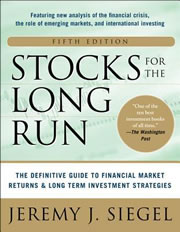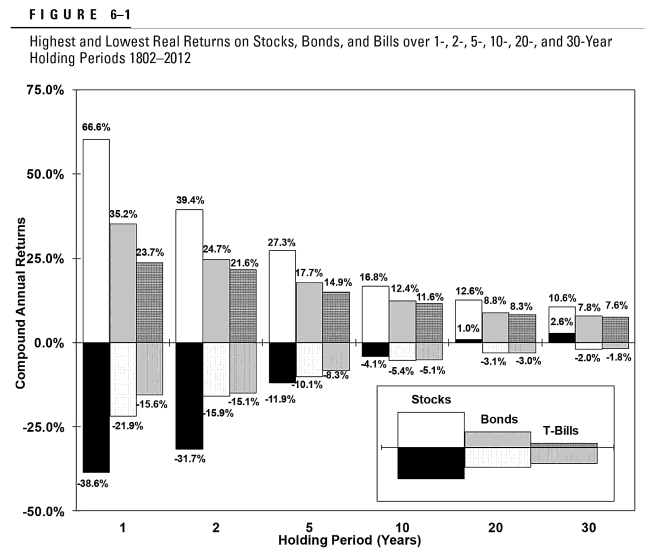 The following is a chart that I usually like to pull out during a crisis when people are scared of investing in the stock market, but since I just found a nicely updated version of it, I had to share. It is taken from Jeremy Siegel’s book Stocks for the Long Run and found via this Vox article about how most people incorrectly view real estate as the best long-term investment*.
The following is a chart that I usually like to pull out during a crisis when people are scared of investing in the stock market, but since I just found a nicely updated version of it, I had to share. It is taken from Jeremy Siegel’s book Stocks for the Long Run and found via this Vox article about how most people incorrectly view real estate as the best long-term investment*.
Here is a chart showing the historical range of real (after-inflation) returns for US stocks, long-term bonds (bonds), and short-term bonds (T-bills) from 1802 to 2012.

The chart shows that over bried time periods, the stock market has been historically more of coin flip than anything else. Over a year, you could get anywhere from +70% to -40%. With bonds and cash, the swings are much less wild. But as you lengthen your holding period, your risk of losing money over that time decreases significantly. For time horizons of 20 and 30 years, only stocks never lost you money after inflation.
Note that the average annual returns for each respective asset class remains the same across all time periods. Via the CFA Institute:

This supports the advice that it doesn’t really matter as much what your plan is, but more that you pick one and stick with it. Going heavy on stocks and then bailing out when they are in a funk, or going heavy on bonds and bailing out when they are in a funk, all that is worse than doing NOTHING and simply riding it out. As they say, it’s not about timing the market, it’s about time IN the market.
I believe it was one of William Bernstein’s books that suggested that young folks who understand this should put as much money now into stocks as possible, as to increase your time horizon. Put 100% of your money into stocks now, and then as you get older put more of your money into bonds to get a balanced mix eventually. This can be hard though, as you’re asking the people with less experience and smallest assets to hold the thing that is most volatile. Going 80/20 or 70/30 from beginning to end is also a reasonable approach in my opinion (and personal experience with my own portfolio).
Now, another well-known professor Robert Shiller reminds us that the period above includes the most economically successful century of the most economically successful country in the world so far… and will not necessarily repeat itself. I’m not saying that you should expect 6% real returns from stocks. Shiller’s CAPE ratio model itself forecasts a 3% real return for stocks over the next decade. I’m focusing on the fact that stocks are investments in productive businesses and that the volatility of the pricing of such businesses will stabilize when held across longer holding periods.
* I would actually argue that the long-term return of real estate is actually not that far behind that of stocks, if you add in the imputed rent from the house. Yes, it may be true that the value of a house doesn’t increase that much over inflation over the long run. But houses are also productive in that they can create their own income! If the value of the rent that you could get from that house is included, that could add another 4% to 6% to the return historically. 5% real return would be smack dab between bonds and stocks.
 The Best Credit Card Bonus Offers – 2025
The Best Credit Card Bonus Offers – 2025 Big List of Free Stocks from Brokerage Apps
Big List of Free Stocks from Brokerage Apps Best Interest Rates on Cash - 2025
Best Interest Rates on Cash - 2025 Free Credit Scores x 3 + Free Credit Monitoring
Free Credit Scores x 3 + Free Credit Monitoring Best No Fee 0% APR Balance Transfer Offers
Best No Fee 0% APR Balance Transfer Offers Little-Known Cellular Data Plans That Can Save Big Money
Little-Known Cellular Data Plans That Can Save Big Money How To Haggle Your Cable or Direct TV Bill
How To Haggle Your Cable or Direct TV Bill Big List of Free Consumer Data Reports (Credit, Rent, Work)
Big List of Free Consumer Data Reports (Credit, Rent, Work)
You’ve proven that the U.S. economy has done very well over the last 200 years although I wonder if the analysis will apply in the future. Diversifying into confederate bonds in the 1860s would have been a mistake.
Exactly what over the preceding 200 years would have made you believe confederate bonds weren’t risky?
I think you missed the point of my post. This is about mean reversion, which can apply to many different asset class including international stocks. From Bogleheads Wiki:
http://www.bogleheads.org/wiki/Mean_reversion
I would never imagined that various tools would resulted big gaps like that. I was very surprised gold would not generate much returns. Haha well. Stock market for the win!
BeSmartRich
Dear Jonathan,
could you tell us on which websites from the CFA institute you found the average annual returns for the different asset classes? I’d be interested to view the sources + to know if they also have numbers for “real estate” and “private equity” and potentially other classes.
thanks,
Rik
Sorry, it was linked before, but this post is from 2015 and it appears the link became dead on their end. It appears to reference research by Jeremy Siegel.